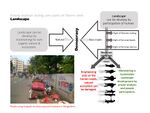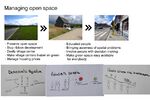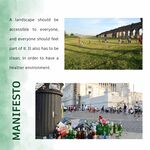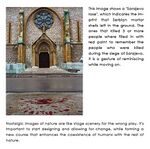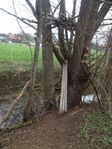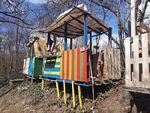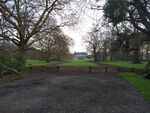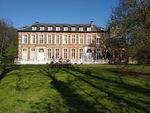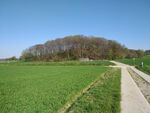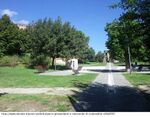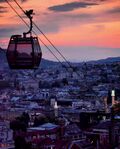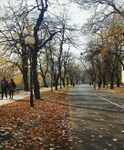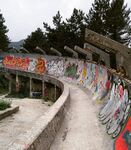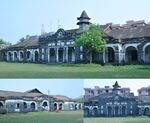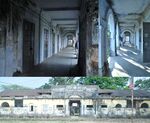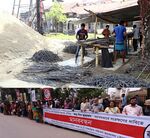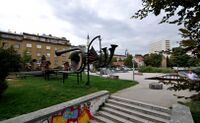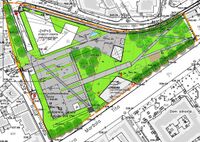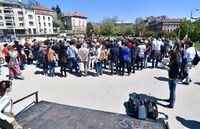LED Online Seminar 2019 - Working Group 6: Difference between revisions
| Line 167: | Line 167: | ||
=== Landscape Democracy Challenge - Anisa === | === Landscape Democracy Challenge - Anisa === | ||
<gallery caption="Hastahana skate park" widths="200px" heights="150px" perrow="5"> | <gallery caption="Saving the Hastahana skate park" widths="200px" heights="150px" perrow="5"> | ||
File:Anisa challenge 1.JPG|Citizens of Sarajevo are threatened by losing one of the few remaining city parks - Hastahana. It used to be a site of a hospital, but now it is one of two skate parks in the country, and is used throughout the year for various festivals and workshops. | File:Anisa challenge 1.JPG|Citizens of Sarajevo are threatened by losing one of the few remaining city parks - Hastahana. It used to be a site of a hospital, but now it is one of two skate parks in the country, and is used throughout the year for various festivals and workshops. | ||
File:Anisa challenge 3.jpg|It was announced that the municipality council is planning on building a Museum of Sarajevo siege, but then they said it was going to be a six-story commercial building and a public garage, with supposedly 89% of the green area. | File:Anisa challenge 3.jpg|It was announced that the municipality council is planning on building a Museum of Sarajevo siege, but then they said it was going to be a six-story commercial building and a public garage, with supposedly 89% of the green area. | ||
Revision as of 08:44, 5 June 2019
--> Back to working group overview
Dear working group members. This is your group page and you will be completing the template gradually as we move through the seminar. Good luck and enjoy your collaboration!
Assignment 1 - Reading and Synthesizing Core Terminology
- You can read more details about this assignment here
- Readings are accessible via the resources page
Step 1: Your Landscape Democracy Manifestoes
Step 2: Define your readings
- Please add your readings selection for the terminology exercise before April 24:
A: Landscape and Democracy -Foysal-Burckhardt, Lucius (1979): Why is landscape beautiful? -Chiara - IFLA EU Landscape democracy resolution
B: Concepts of Participation -Foysal- Day, Christopher (2002): Consensus Design -Anisa - Hester, Randolph (1999): A Refrain with a View -Chiara - Burckhardt, Lucius (1957): Urban Planning and Democracy in: Fezer/Schmitz (Eds.) Rethinking Man-made Environments (2012)
C: Community and Identity -Foysal- Welk Von Mossner, Alexa (2014): Cinematic Landscapes -Anisa - Spirn, Anne (2005): Restoring Mill Creek -Chiara - Hester, Randolph (2006): Design for Ecological Democracy, The MIT Press
D: Designing -Anisa - Hester, Randolph: Life, Liberty and the Pursuit of Sustainable Happiness
E: Communicating a Vision
Steps 3 and 4: Concepts Selection and definition
- Each group member selects three relevant concepts derived from his/her readings and synthesize them/publish them on the wiki by May 15, 2019
- Group members reflect within their groups and define their chosen concepts into a shared definition to be posted on the wiki by June 12, 2019.
- Other group members will be able to comment on the definitions until June 30, 2019
- Each group will also report on their process to come to a set of shared definitions of key landscape democracy concepts on the wiki documentation until July 12, 2019
Concepts and definitions
Author 1: Foysal
- Why landscape is beautiful?
The beauty of a landscape is abstract thinking of the human’s mind and it’s very person to person. So the quality and value of landscape change in every situation. It can be preset of own thinking or a collection of elements what actually a reflection of human minds.
- Consensus Design
The main differences between democracy and consensus are, democratic solutions are come from majority’s mind by voting but the consensus is a process where we can find a reflection of each and every member’s mind of a society. For making a decision human need to think about the future by developing the current condition and by fixing goals. It not about to getting attached only with emotions.
- Cinematic Landscape
A space where the narrative of a film finds its identity. It includes: -Competitive area of filming -Process of framing the images. In the example film its shows how people of Louisiana wetlands suffer and survive from a hurricane. It derives that anthropogenic climate changes are not the only cause for a natural disaster. Man-made river control structures also play a big role in it.
Author 2: Anisa
- "A Refrain With a View" - The paper revolves around encouraging participation and involvement of all the members of community in the design processes, regardless of which group they belong to. Instead of professionalized city management making all the decisions for the community, this approach is set on enriching both the citizens and the area. The concept of the participatory design has been in constant development and underwent great transformations, but it's still relying on another major reformation happening.
- "Restoring of Mill Creek" - Bringing the history of the community closer to people may significantly alter their perception of current state and potential interventions. Landscape literacy is also about having a grip on the available resources and properly allocating them, but it doesn't come without having completely immersed yourself in learning of everything that makes up one's surroundings, and reading into its ongoing dialogues.
- "Life, Liberty and the Pursuit of Sustainable Happiness" - Improving the life quality in terms of sustainability begins with changing the values of the community. The ignorance regarding our surroundings is leading the consumption of non-renewable resources to significant long-term consequences, when in fact, it's raising awareness about pursuing sustainability that may bring new merits and rapture.
Author 3: Chiara
- IFLA EU Landscape Democracy - This paper promotes an olistic view of the landscape, and encourages the different Countries to make everyone participate in the design process, because public spaces belong to everyone.
- Burckhardt Urban Planning and Democracy - The public has little concern of the cityscape, but that doesn't mean that there's no interest. What's lacking is not the concern, but the actual way to express this concern. But we cannot deny that's really difficult to find a meeting point between people with such different backgrounds (architects, urban planners and citizens). Speaking about the cityscape we could say that no one intended it to be as it is, and everybody is always complaining about it. Usually the planning of a city is decided by politicians, but the author's opinion is that urban planners and politicians should cooperate, in order to improve the city and the quality of visible expression of our shared life.
- .......
Author 4: ...
- ......
- .......
- .......
Step 5: Reflection
Step 6: Revised manifestoes
- please look again at your initial manifestoes and update them with any new aspects/prespectives you have taken up during this seminar
Assignment 2 - Your Landscape Symbols
- You can read more details about this assignment here
Landscape Symbols Author 1: Foysal
Landscape Symbols Author 2: Viktor
The abbey’s castle is part of a bigger and very old abbey. The abby is no longer in use, en so is this building. Now they made a cafe in this building and renovated the park around it. In the cafe they give work to people with social problems. It became a hotspot during summer to hang out en relax. 50° 53′ 8.99″ N 4° 32′ 56.77″ E
Landscape Symbols AuthOr 3: Chiara
Landscape Symbols Author 4: Anisa
The mountain where the citizens used to spend their weekends soon became “a symbol of aggression”. Trebević was the only place to go for fresh air, but everything changed and the mountain became the foe. Sarajevo hoped to put much of that past to rest and there was indeed a palpable sense of optimism that arose with the reopening.
This promenade on the Miljacka riverfront, surrounded on the sides with thick rows of trees is closed for the traffic after 5:00 p.m. and on weekends. It allows its users to turn it into whatever they want and need it to be, whether you're walking your dog, roller skating or running marathons. It is a place that gathers everyone in their leisure time and makes up for a catalyst of all activities.
Assignment 3 - Role Play on Landscape Democracy "movers and shakers"
- You can read more details about this assignment here
Assignment 4 - Your Landscape Democracy Challenge
- You can read more details about this assignment here
- Each group member will specify a landscape democracy challenge in his/her environment
Landscape Democracy Challenge 1 (Foysal)
- Preserve the local history of Architecture, Heritage and Landscape
Argue about the history of this building: Some say It was a house of Zamidar (Landlord) Family, others say it was made by the British for institutional or administrative purpose. The most authentic opinion is, the building was used as a printing press for the first local newspaper of Sylhet named ‘’ Sri Hatta Prokash’’ So it’s clear that this building and its surrounding landscape is a part of the history of the local area.
Your references:
- https://www.dhakatribune.com/bangladesh/nation/2019/03/13/historic-architecture-being-demolished-for-hospital-in-sylhet
- https://www.thedailystar.net/city/news/historic-building-faces-demolition-1714915
Landscape Democracy Challenge 2
- Give a title to your challenge
- Yourname challenge 1.jpg
I've already proposed an image regarding Rome's rubbish in my manifesto, and this is why it chose it as a theme for my landscape democracy challenge. Because I think that the principal factor fo the landscape democracy is that every person should feel comfortable with the environment he's in, and having tons of stinky rubbish doesn't help.
- Yourname challenge 2.jpg
caption: what is the issue/conflict (1)
- Yourname challenge 3.jpg
caption: what is the issue/conflict (2)
- Yourname challenge 4.jpg
caption: who are the actors?
Your references:
Landscape Democracy Challenge - Anisa
- Saving the Hastahana skate park
The citizens were surveyed and have voted against any building, but for the maintenance of the area. The protests are been held regularly. The present disturbance is a direct consequence of intentional neglect, which is a common municipal strategy for redesigning green surfaces into the concrete ones, and frantic building of the high-risers on each square centimeter.
Your references:
- ...https://www.skyscrapercity.com/showthread.php?p=153399562
- ...https://zurnal.info/novost/20708/ruse-muzej-i-park-za-djecu-kako-bi-izgradili-jos-jedan-poslovni-centar-
- ...https://www.radiosarajevo.ba/vijesti/lokalne-teme/pogledajte-video-prezentaciju-kako-bi-trebala-izgledati-hastahana/338473
Landscape Democracy Challenge 4
- Give a title to your challenge
- Yourname challenge 1.jpg
caption: why did you select this case?
- Yourname challenge 2.jpg
caption: what is the issue/conflict (1)
- Yourname challenge 3.jpg
caption: what is the issue/conflict (2)
- Yourname challenge 4.jpg
caption: who are the actors?
Your references:
- ...
- ...
Your Democratic Change Process
- Add Title
- Your Democratic Change Process Slide1.jpg
caption: ...
- Your Democratic Change Process Slide2.jpg
caption: ...
- Your Democratic Change Process Slide3.jpg
caption: ...
- Your Democratic Change Process Slide4.jpg
caption: ...
Reflection
- ....
- ....
- ....
Conclusion:
- ....
- ....
- ....
Your references
- ...
- ...
- ...
